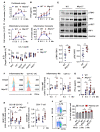NLRP12 is an innate immune checkpoint for repressing IFN signatures and attenuating lupus nephritis progression
- PMID: 36719379
- PMCID: PMC9888378
- DOI: 10.1172/JCI157272
NLRP12 is an innate immune checkpoint for repressing IFN signatures and attenuating lupus nephritis progression
Erratum in
-
NLRP12 is an innate immune checkpoint for repressing IFN signatures and attenuating lupus nephritis progression.J Clin Invest. 2023 May 1;133(9):e171350. doi: 10.1172/JCI171350. J Clin Invest. 2023. PMID: 37115700 Free PMC article. No abstract available.
Abstract
Signaling driven by nucleic acid sensors participates in interferonopathy-mediated autoimmune diseases. NLRP12, a pyrin-containing NLR protein, is a negative regulator of innate immune activation and type I interferon (IFN-I) production. Peripheral blood mononuclear cells (PBMCs) derived from systemic lupus erythematosus (SLE) patients expressed lower levels of NLRP12, with an inverse correlation with IFNA expression and high disease activity. NLRP12 expression was transcriptionally suppressed by runt-related transcription factor 1-dependent (RUNX1-dependent) epigenetic regulation under IFN-I treatment, which enhanced a negative feedback loop between low NLRP12 expression and IFN-I production. Reduced NLRP12 protein levels in SLE monocytes was linked to spontaneous activation of innate immune signaling and hyperresponsiveness to nucleic acid stimulations. Pristane-treated Nlrp12-/- mice exhibited augmented inflammation and immune responses; and substantial lymphoid hypertrophy was characterized in NLRP12-deficient lupus-prone mice. NLRP12 deficiency mediated the increase of autoantibody production, intensive glomerular IgG deposition, monocyte recruitment, and the deterioration of kidney function. These were bound in an IFN-I signature-dependent manner in the mouse models. Collectively, we reveal a remarkable link between low NLRP12 expression and lupus progression, which suggests the impact of NLRP12 on homeostasis and immune resilience.
Keywords: Autoimmunity; Cytokines; Inflammation; Innate immunity; Lupus.
Conflict of interest statement
Figures








References
Publication types
MeSH terms
Substances
LinkOut - more resources
Full Text Sources
Medical
Molecular Biology Databases

